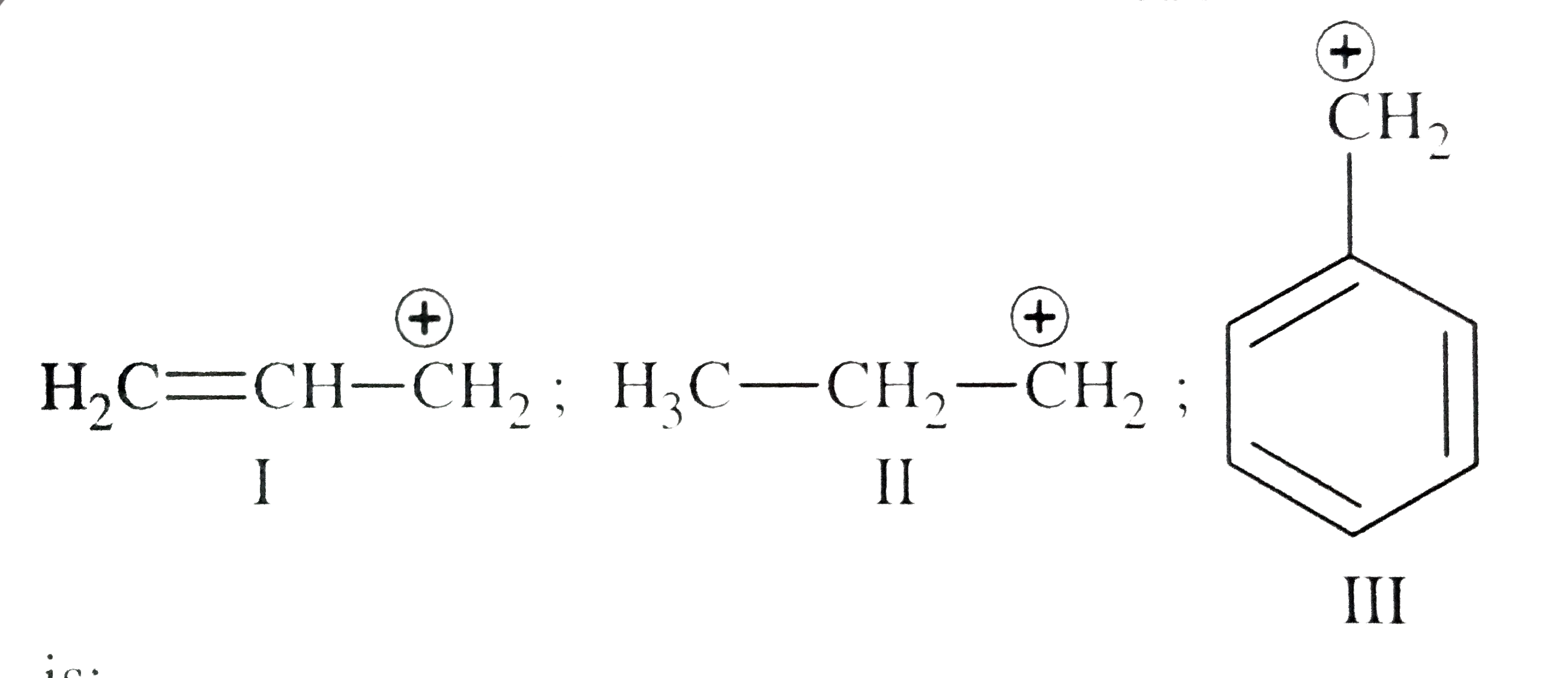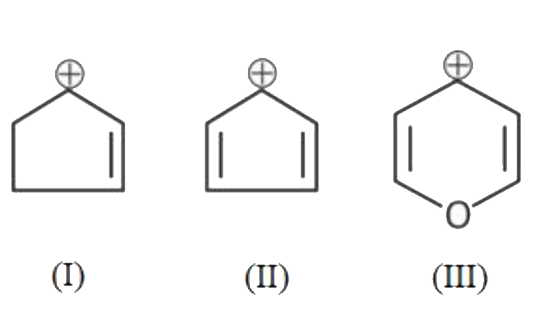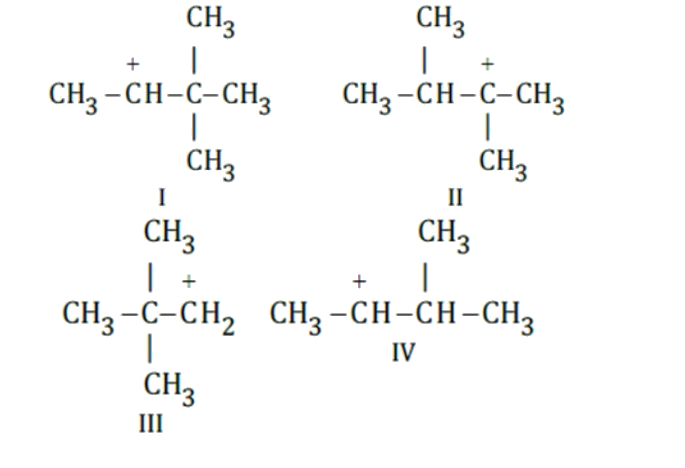Hyperconjugation is most useful for stabilizing which of the following carbocations?
Neo-pentyl
Tert. Butyl
Iso propyl
Ethyl
The correct Answer is:B
To determine which carbocation is most stabilized by hyperconjugation, we will analyze each of the given options: neopentyl, tertiary butyl, isopropyl, and ethyl carbocations.
1. Understanding Hyperconjugation:
- Hyperconjugation, also known as no bond resonance, involves the delocalization of sigma electrons from C-H bonds that are adjacent to a positively charged carbon atom (the carbocation). The more alpha hydrogens present, the greater the potential for hyperconjugation and stabilization.
2. Analyzing Tertiary Butyl Carbocation:
- Structure: (CH3)3C^+
- This carbocation has three alpha carbons (CH3 groups) attached to the positively charged carbon.
- Each of these CH3 groups has 3 hydrogen atoms, leading to a total of 9 alpha hydrogens.
- Therefore, there are 9 possible hyperconjugating structures.
3. Analyzing Neopentyl Carbocation:
- Structure: (CH3)4C^+CH2^+
- The positively charged carbon is adjacent to only one carbon (the CH2 group).
- This alpha carbon has no hydrogen atoms attached.
- Therefore, there is no hyperconjugation possible in this case.
4. Analyzing Isopropyl Carbocation:
- Structure: (CH3)2C^+CH3
- This carbocation has two alpha carbons (CH3 groups) attached to the positively charged carbon.
- Each of these CH3 groups has 3 hydrogen atoms, leading to a total of 6 alpha hydrogens.
- Therefore, there are 6 possible hyperconjugating structures.
5. Analyzing Ethyl Carbocation:
- Structure: CH3CH2^+
- The positively charged carbon is adjacent to one carbon (the CH2 group).
- This alpha carbon has 3 hydrogen atoms attached.
- Therefore, there are 3 possible hyperconjugating structures.
6. Comparing Stabilization:
- Tertiary Butyl: 9 hyperconjugating structures
- Neopentyl: 0 hyperconjugating structures
- Isopropyl: 6 hyperconjugating structures
- Ethyl: 3 hyperconjugating structures
7. Conclusion:
- The carbocation that is most stabilized by hyperconjugation is the tertiary butyl carbocation (Option B), as it has the highest number of hyperconjugating structures.
Final Answer:
Option B: Tertiary Butyl
- Hyperconjugation, also known as no bond resonance, involves the delocalization of sigma electrons from C-H bonds that are adjacent to a positively charged carbon atom (the carbocation). The more alpha hydrogens present, the greater the potential for hyperconjugation and stabilization.
- Structure: (CH3)3C^+
- This carbocation has three alpha carbons (CH3 groups) attached to the positively charged carbon.
- Each of these CH3 groups has 3 hydrogen atoms, leading to a total of 9 alpha hydrogens.
- Therefore, there are 9 possible hyperconjugating structures.
- Structure: (CH3)4C^+CH2^+
- The positively charged carbon is adjacent to only one carbon (the CH2 group).
- This alpha carbon has no hydrogen atoms attached.
- Therefore, there is no hyperconjugation possible in this case.
- Structure: (CH3)2C^+CH3
- This carbocation has two alpha carbons (CH3 groups) attached to the positively charged carbon.
- Each of these CH3 groups has 3 hydrogen atoms, leading to a total of 6 alpha hydrogens.
- Therefore, there are 6 possible hyperconjugating structures.
- Structure: CH3CH2^+
- The positively charged carbon is adjacent to one carbon (the CH2 group).
- This alpha carbon has 3 hydrogen atoms attached.
- Therefore, there are 3 possible hyperconjugating structures.
- Tertiary Butyl: 9 hyperconjugating structures
- Neopentyl: 0 hyperconjugating structures
- Isopropyl: 6 hyperconjugating structures
- Ethyl: 3 hyperconjugating structures
- The carbocation that is most stabilized by hyperconjugation is the tertiary butyl carbocation (Option B), as it has the highest number of hyperconjugating structures.
Option B: Tertiary Butyl
Topper's Solved these Questions
- BOOK - AAKASH INSTITUTE ENGLISHCHAPTER - ORGANIC CHEMISTRY: SOME BASIC PRINCIPLE AND TECHNIQUESEXERCISE - SECTION-B OBJECTIVE TYPE QUESTION (ONE OPTION IS CORRECT)37videos
ORGANIC CHEMISTRY: SOME BASIC PRINCIPLE AND TECHNIQUES
- BOOK - AAKASH INSTITUTE ENGLISHCHAPTER - ORGANIC CHEMISTRY: SOME BASIC PRINCIPLE AND TECHNIQUESEXERCISE - SECTION-C OBJECTIVE TYPE QUESTION (MORE THAN ONE OPTIONS ARE CORRECT)18videos
ORGANIC CHEMISTRY: SOME BASIC PRINCIPLE AND TECHNIQUES
- BOOK - AAKASH INSTITUTE ENGLISHCHAPTER - ORGANIC CHEMISTRY: SOME BASIC PRINCIPLE AND TECHNIQUESEXERCISE - ILLUSTRATION3videos
ORGANIC CHEMISTRY: SOME BASIC PRINCIPLE AND TECHNIQUES
- BOOK - AAKASH INSTITUTE ENGLISHCHAPTER - ORGANIC CHEMISTRY : SOME BASIC PRINCIPLES AND TECHNIQUES EXERCISE - Assignment(Section-D)(Assertion - Reason Type Questions)15videos
ORGANIC CHEMISTRY : SOME BASIC PRINCIPLES AND TECHNIQUES
- BOOK - AAKASH INSTITUTE ENGLISHCHAPTER - POLYMERSEXERCISE - ASSIGNMENT (SECTION-D)13videos
POLYMERS
Similar Questions
Knowledge Check
- Question 1 - Select One
The correct order of stability of the following carbocations is :
ACH3CH2+CH2>CH2=CH−+CH2>CH2=CH+CHCH3>CH2=CH+C(CH3)2BCH2=CHC+H2>CH3CH2+CH2>CH2=CH+C(CH3)2>CH2=CH+CHCH3CCH2=CH+C(CH3)2>CH2=CH+CHCH3>CH2=CH+CH2>CH3CH2+CH2DCH2=CH−+CHCH3>CH2=CH+C(CH3)2>CH3CH2−+CH2>CH2=CH+CH2
The order of stability of the following carbocations:
 View Solution
View SolutionCompare the stability of following carbocations .
 View Solution
View SolutionReaction intermdiates are short lived species and are highly reactive. They are formed by heterolytic and homolytic bond fission. There are various types of reaction intermediates in which the most important are carbocation , carbanion and free radical.
Carbocation is an organic species in which carbon have positive charge and six electrons in its outermost shell. The stability of carbocation can be increased by positive inductive effect, hyperconjugation and delocalisation. If α-atom with respect to carbocation has one or more lone pair of electron then lone pair of electron strongly stabilises the carbocation due to octet completion.
Species in which carbon have negative charge is called carbanion. Carbanion carries three bond pairs and one lone pair. The stability of carbanion can be increased by negative inductive effect, negative mesomeric effect and delocalisation.
Free radical is a species which have seven electrons in its outermost shell. The stability of free radical can be increased by hyperconjugation and delocalisation.
The stability order of following carbocations is
 View Solution
View SolutionWhich of the following is most stable carbocation?
View SolutionHyperconjugation involves overlap of which of the following orbitals?
View SolutionWhich of the following carbocations is most stable ?
 View Solution
View SolutionWhich of the following carbocations is most stable ?
View Solution

